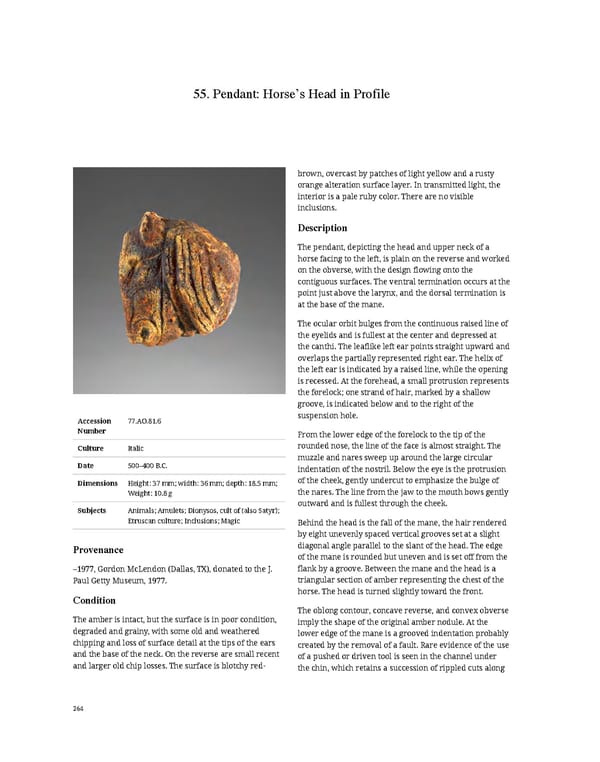55. Pendant: Horse’s Head in Profile brown, overcast by patches of light yellow and a rusty orange alteration surface layer. In transmitted light, the interior is a pale ruby color. There are no visible inclusions. Description The pendant, depicting the head and upper neck of a horse facing to the left, is plain on the reverse and worked on the obverse, with the design flowing onto the contiguous surfaces. The ventral termination occurs at the point just above the larynx, and the dorsal termination is at the base of the mane. The ocular orbit bulges from the continuous raised line of the eyelids and is fullest at the center and depressed at the canthi. The leaflike left ear points straight upward and overlaps the partially represented right ear. The helix of the left ear is indicated by a raised line, while the opening is recessed. At the forehead, a small protrusion represents the forelock; one strand of hair, marked by a shallow groove, is indicated below and to the right of the Accession 77.AO.81.6 suspension hole. Number From the lower edge of the forelock to the tip of the Culture Italic rounded nose, the line of the face is almost straight. The muzzle and nares sweep up around the large circular Date 500–400 B.C. indentation of the nostril. Below the eye is the protrusion Dimensions Height: 37 mm; width: 36 mm; depth: 18.5 mm; of the cheek, gently undercut to emphasize the bulge of Weight: 10.8 g the nares. The line from the jaw to the mouth bows gently outward and is fullest through the cheek. Subjects Animals; Amulets; Dionysos, cult of (also Satyr); Etruscan culture; Inclusions; Magic Behind the head is the fall of the mane, the hair rendered by eight unevenly spaced vertical grooves set at a slight Provenance diagonal angle parallel to the slant of the head. The edge of the mane is rounded but uneven and is set off from the –1977, Gordon McLendon (Dallas, TX), donated to the J. flank by a groove. Between the mane and the head is a Paul Getty Museum, 1977. triangular section of amber representing the chest of the Condition horse. The head is turned slightly toward the front. The oblong contour, concave reverse, and convex obverse The amber is intact, but the surface is in poor condition, imply the shape of the original amber nodule. At the degraded and grainy, with some old and weathered lower edge of the mane is a grooved indentation probably chipping and loss of surface detail at the tips of the ears created by the removal of a fault. Rare evidence of the use and the base of the neck. On the reverse are small recent of a pushed or driven tool is seen in the channel under and larger old chip losses. The surface is blotchy red- the chin, which retains a succession of rippled cuts along 264
 Ancient Carved Ambers in the J. Paul Getty Museum Page 273 Page 275
Ancient Carved Ambers in the J. Paul Getty Museum Page 273 Page 275